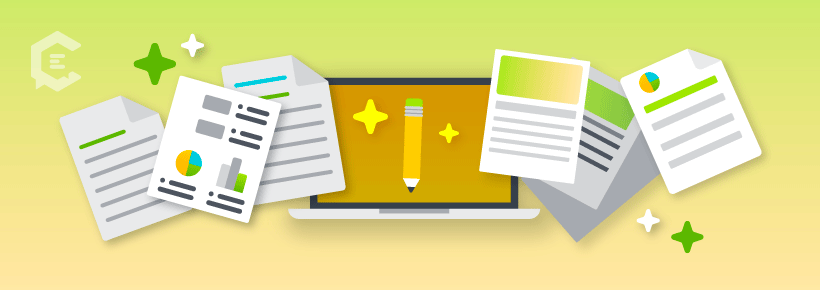Laptop open. Check. Cold drink. Check. Data points. Wait, what? If your content marketing client is asking you to take a data-driven approach to your next blog post or case study, you might be left wondering what to do. Marketers often adopt key tenets from the world of journalism, including the use of statistics, numbers and percentages, to bolster their writing.
The new practice of data journalism is not a completely new type of journalism. Rather, think of data analysis as simply part of journalism for the modern world. Reporting has always involved numbers. Today, technology enables journalists to use numbers less anecdotally, more authoritatively, and to uncover otherwise invisible stories. — The American Press Institute
Weaving surprising or informative data into your marketing copy adds depth to your level of storytelling by introducing an element the reader can verify with the source. This inspires confidence. From a marketer’s perspective, data impacts marketing success, according to the omnichannel analytics management team at V12.
Here are a few takeaways from the piece:
- Marketers are adding value to their campaigns by incorporating CRM data and real-time data from analytics.
- 88 percent of marketers use data from third-party resources to better understand their customers.
- Marketing data helps to better focus on targeting offers, content and messaging.
- 44 percent of marketers have data management platforms at their fingertips.
- Data marketers are harvesting purchasing behaviors, browsing histories, device usage, social media habits and real-time geo-tracking information.
When do writers write about data?
Before we get too far into how to write about data, you might wonder when a client will ask for this type of approach. It can be requested for any type of content, really. I’ve been asked to include a quick stat or appealing number in everything from landing page copy to requesting testimonials from happy customers.
Here are a few common content types that are strengthened by incorporating data:
- Article
- Blog post
- Case study
- Data study
- Ebook
- Guide
- Infographic
- Landing page
- Presentations
- Press release
- Testimonial
Let’s dig into a few examples of marketing copy that glows thanks to the use of a data journalism approach. Then, we’ll pick apart the do’s and don’ts for this type of writing so you can incorporate it into your data-loving client assignments.
2 examples of data-supported content
In June of 2019, The Global Editors Network (GEN) announced the Data Journalism Awards 2019 at the GEN Summit ceremony and gala in Athens, Greece (view the full list of winners). Among the popular news reporting agencies, including the Associated Press and Reuters, you’ll see a few business organizations highlighted that understand the value of data-based content creation.
1. The Civio Foundation
This independent non-profit based in Spain monitors public authorities and lobbies for transparency. Eva Belmonte, co-director and head of journalistic projects at The Civio Foundation, is known for her investigative articles published on Our Daily Official Gazette. This article dives into the rising cost of butane cylinders, a primary heat source for Spaniards.
To make the story more easily understood and intriguing, she shares the exact prices of butane, rather than simply saying it has increased, complete with a chart for visual learners. She also explains how the price of butane is calculated by sharing exact numbers and a formula. This deeper level of reporting helps answer the why question for readers while building authority and loyalty for her non-profit organization
Additional winners to note include The Pudding (a digital publication explaining cultural debates with visual essays) and Factchecker.in (a database of religion-based hate crimes in India).
2. National Sleep Research Resource
This example isn’t final written copy, but rather, the type of data you might be presented with to use for your writing. Browse this page from the National Sleep Research Resource regarding their Sleep Heart Health Study. You’ll quickly learn who funded the project (the National Heart, Lung, and Blood Institute and the National Institutes of Health), the population size (5,804 adults ages 40+) and a whole lot more.
I’m sharing this so you can see the types of documents and citation requirements you may be asked to study for the research portion of your writing. Tip: As a writer, I tend to budget extra hours for my writing project when I see these types of documents included with an assignment brief. Data documents require careful examination and understanding before drafting begins.
How can writing about data enhance your content?
The United Nations Economic Commission for Europe (UNECE) defines writing stories about numbers as ‘statistical stories.’ In the content marketing world, you might hear this referred to as data-supported or data-driven content. In journalism, it’s data journalism. In the end, these styles of writing ultimately are narratives supported by statistics.
Readers tend to recall ideas more easily than they do data. A statistical story conveys a message that tells readers what happened, who did it, when and where it happened, and hopefully, why and how it happened. — United Nations Economic Commission for Europe
Writing about data enhances your content creation efforts by informing readers via facts and giving them quantified perspectives on a topic. This helps readers understand the significance, relevance and importance of the points you’re driving home in the copy. Data is used as a guide to help inform decision-making, improves relations with consumers and creates greater viability for a product, service or mission, per the UNECE.
A quick statistics primer for data writers
As the writer on the project, you’ll be supplied with reports, studies, charts, lists, spreadsheets or other data to complete your project. As you synthesize information from these resources, you may come across data terminology that’s new to you. Keep these lists of statistical terms provided by the Journalist’s Resource from the Harvard Kennedy School Shorenstein Center on Media, Politics and Public Policy and the University of California at Berkeley Department of Statistics handy.
In the meantime, here are a few key terms to browse:
- Average: In statistics, this term is very ambiguous. It means the arithmetic mean, but can also reflect the media, mode or geometric mean.
- Cohort: This is a group of subjects sharing a defined characteristic. The people you’re addressing based on a buyer persona are generally cohorts.
- Correlation: This is when two variables move together. They can be positive (both moving the same direction) or negative (repelling in opposite directions).
- Elasticity: This how much a change in one variable affects another.
- Margin of error: This reflects the measure of uncertainty of an estimate. It’s a good idea to always include this information when reporting on percentages.
- Mean: When adding a list of numbers, then dividing by the number of numbers, you get the mean of that list.
- Median: This reflects the number situated in the middle of the list of numbers.
- Mode: In a list of numbers, the mode is the most frequent, common number appearing on the list.
- Moving average: This calculation analyzes a series of subsets of the full data set to help rule out random fluctuations in the numbers.
- N: This single letter represents the number of people/subjects involved in the study/report.
- Parameter: This is a numerical property of a population. For example, the mean would be a parameter.
- Population: This refers to the full collection of numbers, people, units, etc. being studied.
- Random sample: These are study participants chosen by chance.
- Sample: This a portion of a population.
- Stratified sample: These are carefully chosen subjects based on characteristics of the population at large.
- Standard deviation: This number reflects how much variation there is within a group of variables.
- Unit: This is one member of a population.
- Variable: This is a characteristic that differs from unit to unit.
3 do’s when writing about data
If you haven’t gathered it yet, data writers are a specialized breed. They find joy in analyzing charts, adore numbers and can blend it all together into a narrative that makes the findings engaging and easily digestible by readers. Whether you’re testing the waters with your first data-driven content piece or you’re a seasoned writer needing a refresher in this niche, keep these do’s and don’ts top of mind.
1. Do evaluate the source/collection process of the data.
Every bit of research out there is funded, created and supported by someone or something with personal interests. When digging up information to cite in your content, take a moment to look beyond the report summary and findings. Where did it originate? Is there a partnership or monetary funding that conflicts with your marketing partner? Do the findings seem to be swayed to represent the agenda of one of the funders? Think like an investigative journalist.
Diana Aleman, editor for SAGE Stats and U.S. Political Stats, shares some tips for evaluating a data source. She says numbers can easily be manipulated, so it’s best to be critical and also study the questions asked during the study. Were they confusing or leading? And how big is the sample size? Is it enough to draw accurate conclusions? And finally, why was the information created in the first place? Were there incentives for sharing the information?
2. Do share the full data set.
Readers are smart. When they come across an intriguing statistic, they often want to click through to learn more or at least know they have access to additional details. Get into the habit of linking to the full report, additional charts or summaries of the data you’re discussing. This gives readers confidence in both your reporting skills, but also empowers them to review the data for themselves.
The Academy of Family Physicians of Malaysia (AFPM) shares rules for submitting data-driven manuscripts to medical journals. They explain, “The first thing the author needs to do is to make a selection of what is worth presenting. Having decided that, he/she will need to convey the message effectively using a mixture of text, tables and graphics. The level of details required depends a great deal on the target audience of the paper.”
3. Do offer key insights and analysis.
As a marketing writer, your task is to create easily consumable text. Data can get heavy with numbers, lingo and formulas. Mindfully provide narration and interpretation of the data, per the AFPM. You don’t want the reader to have to analyze the data and form their own conclusion. That’s your job. It’s a reader’s job to absorb the information, then dig deeper into the data themselves if they desire a broader scope of the information — by choice, not necessity.
You’ve likely heard that taking a storytelling approach is effective in marketing, and that rings true especially when breaking down complex topics in the world of data reporting. Our brains are wired to remember stories. So, by transforming data into narrative, you’re helping your brand client become more memorable.
4 don’ts when writing about data
OK, you know to be fair, unbiased, thorough and engaging. But, when it comes to doing the legwork for these types of pieces, it’s easy to get bogged down in information. We get it. As you work through your next data-focused content piece, run through this checklist a few times. It could save you hours of edits.
1. Don’t allow for interpretation errors.
If you don’t understand some of the lingo, look it up! Ask questions. Scientific data isn’t everyday language and may require a few extra levels of research to fully comprehend.
2. Don’t present skewed numbers.
Since you’re working for a brand, and they may want to be represented in a specific way, it can be tempting to only highlight the data that supports their agenda. Meet the client’s requirements, but also include a mention or link to information that tells the entire story. Discerning readers will appreciate this unbiased approach.
3. Don’t breach confidentiality with your sources.
If they’ve shared research material with you in confidence, it’s never advisable to leak that proprietary information to anyone else. A casual social post about what you’re specifically writing about might be over the line. Stay quiet about insider data.
4. Don’t use weak generalizations.
When writing about data, specifics are preferred. Exact numbers, percentages and details are what the reader wants. Avoid language such as “may” or “generally,” unless it’s requested by the client in their editorial guidelines.
Takeaway tips for writing about data
Writing about data requires an analytical thinking process merged with creative writing to bring numbers to life for your reader. As you work your magic at the keyboard, keep these writing tips in mind.
- Research papers and analytics reports often use terminology from statistics. If you write about data often, get familiar with this industry lingo.
- Data sources vary. Know who created and published the information. Are they credible?
- Link to the original report so readers can engage with the information directly, if they so choose.
- Explain what the numbers mean. That’s why you’re writing about them!
If the idea of analyzing spreadsheets, reading about experiments or reviewing survey reports makes you smile from ear to ear, combine it with your love of writing. Claim a ClearVoice Portfolio to get your skills in front of our brand clients who crave creative data-focused writers like you.







